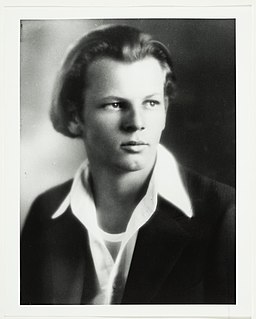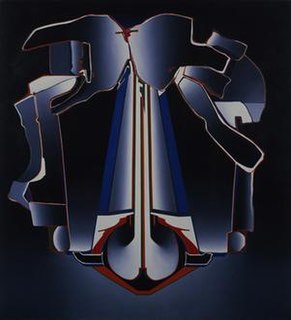
Paul Jackson Pollock was an American painter and a major figure in the abstract expressionist movement.

Elaine Marie Catherine de Kooning was an Abstract Expressionist and Figurative Expressionist painter in the post-World War II era. She wrote extensively on the art of the period and was an editorial associate for Art News magazine.
The Art of This Century gallery was opened by Peggy Guggenheim at 30 West 57th Street in Manhattan, New York City on October 20, 1942. The gallery occupied two commercial spaces on the seventh floor of a building that was part of the midtown arts district including the Museum of Modern Art, the Museum of Non-Objective Painting, Helena Rubinstein's New Art Center, and numerous commercial galleries. The gallery exhibited important modern art until it closed in 1947, when Guggenheim returned to Europe. The gallery was designed by architect, artist, and visionary Frederick Kiesler.
Federico Solmi is a visual artist based in Brooklyn, New York.
Cora Cohen is an American artist whose works include paintings, drawings, photographs, and altered x rays. Cohen is most known for her abstract paintings and is often identified as continuing the tradition of American Abstraction. The New York Times' critic Michael Brenson wrote of her 1984 exhibition, Portraits of Women: "The works are dense, brooding and yet elated. The turbulence of the paint not only looks but also feels like freedom." Cohen interviewed many other artists also associated with continuing the tradition of American Abstraction for Bomb Magazine including; Ralph Humphrey, Dona Nelson, Craig Fisher, Carl Ostendarp and Joan Mitchell. Her work has also been identified with traditions of European abstraction, and specifically German abstraction, including the work of Wols, Sigmar Polke, Gerhard Richter. She began exhibiting in Germany in the early nineties and continues to show at some of its most prestigious institutions.
Squeak Carnwath is a contemporary American painter and arts educator. She is a Professor Emerita of Art at University of California, Berkeley.
Charles Seliger was an American abstract expressionist painter. He was born in Manhattan June 3, 1926, and he died on 1 October 2009, in Westchester County, New York. Seliger was one of the original generation of abstract expressionist painters connected with the New York School.

Deborah Remington was an American abstract painter. Her most notable work is characterized as Hard-edge painting abstraction.

Katherine Bradford, née Houston, is an American artist based in New York, best known for paintings of swimmers, superheroes and ships that critics describe as simultaneously representational and abstract, luminous, and richly metaphorical. She began her career as an artist relatively late in life and has achieved her widest recognition in her seventies, through New York gallery shows at CANADA, Sperone Westwater, and Edward Thorp. Writing about her work's adventurousness, open-ended process, refusal of canonical either/or conundrums and relevance to younger artists, critic John Yau called Bradford, among others, "an important figure in an alternative history that has yet to receive the attention it deserves."

Barbara Takenaga is an American artist known for swirling, abstract paintings that have been described as psychedelic and cosmic, as well as scientific, due to their highly detailed, obsessive patterning. She gained wide recognition in the 2000s, as critics such as David Cohen and Kenneth Baker placed her among a leading edge of artists renewing abstraction with paintings that emphasized visual beauty and excess, meticulous technique, and optical effects. Her work suggests possibilities that range from imagined landscapes and aerial maps to astronomical and meteorological phenomena to microscopic views of cells, aquatic creatures or mineral cross-sections. In a 2018 review, The New Yorker described Takenaga as "an abstractionist with a mystic’s interest in how the ecstatic can emerge from the laborious."
Sonia Gechtoff was an American abstract expressionist painter. Her primary medium was painting but she also created drawings and prints.
Norman Toynton is a British abstract painter who lived for many years in America, where his work was acclaimed for its 'grand visual and tactile splendour' and for 'marshal(ling) all the sensuous force of color and oil paint to induce us to look with truly questioning attention'. He was the Chair of Fine Arts at the Massachusetts College of Art and exhibited widely in New York and Boston. In 2006 he returned to England, where he lives and works on the North Norfolk coast and is currently in an exhibition at the Yorkshire Sculpture Park.
Amy Feldman is an American abstract painter from Brooklyn, New York.

Gary Stephan is an American abstract painter born in Brooklyn who has exhibited his work throughout the United States and Europe.
Amy Myers is an American artist. She is best known for her large-scale charcoal and pastel drawings, which depict complicated worlds reminiscent of scientific patterns. Her father was a physicist, a fact often noted as an influence on the aesthetics and structure of her work.
Clarity Haynes is a queer feminist American artist and writer. She currently lives and works in New York, NY. Haynes is best known for her unconventional depictions of the female torso. She is a former member of the tART Collective and the Corpus VI Collective.

Joanna Pousette-Dart is an American abstract artist based in New York City. She is best known for her distinctive shaped-canvas paintings, which typically consist of two or three stacked, curved-edge planes whose arrangements—from slightly precarious to nested—convey a sense of momentary balance with the potential to rock, tilt or slip. She overlays the planes with meandering, variable arabesque lines that delineate interior shapes and contours, often echoing the curves of the supports. Her work draws on diverse inspirations, including the landscapes of the American Southwest, Islamic, Mozarabic and Catalan art, Chinese landscape painting and calligraphy, and Mayan art, as well as early and mid-20th-century modernism. Critic John Yau writes that her shaped canvasses explore "the meeting place between abstraction and landscape, quietly expanding on the work of predecessors", through a combination of personal geometry and linear structure that creates "a sense of constant and latent movement."

Louise Belcourt is a Canadian-American artist based in New York, known for elusive, largely abstract paintings that blend modernist formal play, a commitment to the physical world, and a visual language that shifts between landscape and the body, architecture and geometric form. New York Times critic Ken Johnson writes of her earlier work, "balancing adroitly between Color Field abstraction and Pop-style representation, Ms. Belcourt's paintings invite meditation on the perceptual, the conceptual and how our minds construct the world." Describing her later evolution, David Brody writes in Artcritical, "Hard-nosed Canadian empiricism and Brooklyn grit seem to combine in Belcourt’s work to undermine stylistic stasis."

Harriet Korman is an American abstract painter based in New York City, who first gained attention in the early 1970s. She is known for work that embraces improvisation and experimentation within a framework of self-imposed limitations that include simplicity of means, purity of color, and a strict rejection of allusion, illusion, naturalistic light and space, or other translations of reality. Writer John Yau describes Korman as "a pure abstract artist, one who doesn’t rely on a visual hook, cultural association, or anything that smacks of essentialization or the spiritual," a position he suggests few post-Warhol painters have taken. While Korman's work may suggest early twentieth-century abstraction, critics such as Roberta Smith locate its roots among a cohort of early-1970s women artists who sought to reinvent painting using strategies from Process Art, then most associated with sculpture, installation art and performance. Since the 1990s, critics and curators have championed this early work as unjustifiably neglected by a male-dominated 1970s art market and deserving of rediscovery.

Heide Fasnacht is a New York City-based artist who works in sculpture, drawing, painting and installation art. Her work explores states of flux, instability and transformation caused by human action and natural events. Since the mid-1990s, she has been known for sculptures and drawings that recreate momentary phenomena such as sneezes, geysers and demolitions—in sometimes abstract or cartoony form—that are temporally and spatially "frozen" for consideration of their aesthetic, perceptual, social or sensate qualities. In the late 2010s, she has expanded these themes in paintings that examine lost and neglected childhood sites, such as playgrounds and amusement parks. ARTnews critic Ken Shulman has described her work as "chart[ing] the fluid dialogue between second and third dimensions, motion and inertia, creation and ruin."












